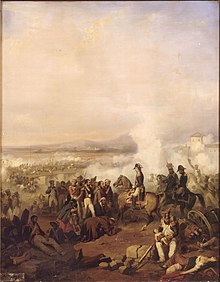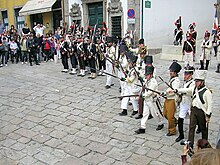
The Battle of Gamonal was fought on 10 November 1808, during the Peninsular War in the village of Gamonal, near Burgos, Spain. A French army under Soult overwhelmed the outnumbered Spanish troops under General Belvedere, opening central Spain, including Madrid, to invasion.

At the Battle of Fuentes de Oñoro, the Anglo-Portuguese Army under Wellington checked an attempt by the French Army of Portugal under Marshal André Masséna to relieve the besieged city of Almeida.

In the Battle of Vimeiro on 21 August 1808, the British under General Arthur Wellesley defeated the French under Major-General Jean-Andoche Junot near the village of Vimeiro, near Lisbon, Portugal, during the Peninsular War. This battle put an end to the first French invasion of Portugal.
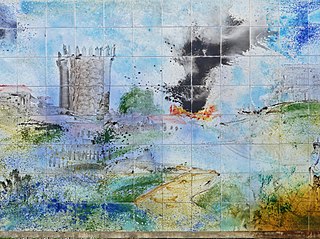
The siege of Chaves refers to the French siege and capture of Fort São Francisco and the town of Chaves, Portugal from 10 to 12 March 1809, and the subsequent siege and recapture of the fort by Portuguese forces from 21 to 25 March 1809, during the second French invasion of Portugal in the Peninsular War.

At the Battle of Roliça, the first battle fought by the British army during the Peninsular War, an Anglo-Portuguese army under Sir Arthur Wellesley defeated an outnumbered Imperial French division under General of Division Henri François Delaborde, near the village of Roliça in Portugal. The French retired in good order.

The Battle of Albuera was a battle during the Peninsular War. A mixed British, Spanish and Portuguese corps engaged elements of the French Armée du Midi at the small Spanish village of Albuera, about 20 kilometres (12 mi) south of the frontier fortress-town of Badajoz, Spain.

The Battle of Buçaco or Bussaco, fought on 27 September 1810 during the Peninsular War in the Portuguese mountain range of Serra do Buçaco, resulted in the defeat of French forces by Lord Wellington's Anglo-Portuguese Army.

General Julien Augustin Joseph Mermet fought in the Napoleonic Wars as a division commander in Italy and in the Peninsular War.
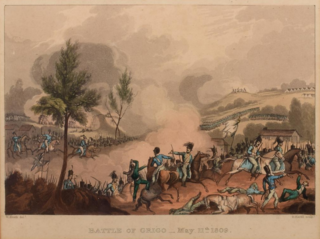
The Battle of Grijó ended in victory for the Anglo-Portuguese Army commanded by Lieutenant-General Sir Arthur Wellesley over the French army commanded by Marshal Nicolas Soult during the Second French invasion of Portugal in the Peninsular War. The next day, Wellesley drove Soult from Porto in the Second Battle of Porto.
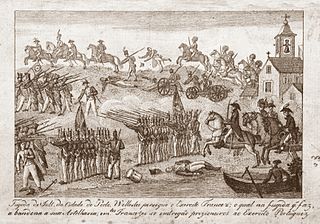
The Second Battle of Porto, also known as the Battle of the Douro or the Crossing of the Douro, took place on 12 May 1809. General Arthur Wellesley's Anglo-Portuguese Army defeated Marshal Soult's French troops and took back the city of Porto. After taking command of the British troops in Portugal on 22 April, Wellesley immediately advanced on Porto and made a surprise crossing of the Douro River, approaching Porto where its defences were weak. Soult's late attempts to muster a defence were in vain. The French quickly abandoned the city in a disorderly retreat.

The Battle of Sabugal was an engagement of the Peninsular War which took place on 3 April 1811 between Anglo-Portuguese forces under Arthur Wellesley and French troops under the command of Marshal André Masséna. It was the last of many skirmishes between Masséna's retreating French forces and those of the Anglo-Portuguese under Wellington, who were pursuing him after the failed 1810 French invasion of Portugal.

Louis Henri Loison briefly joined the French Army in 1787 and after the French Revolution became a junior officer. Blessed with military talent and courage, he rapidly rose to general officer rank during the French Revolutionary Wars. He got into difficulties because of his fondness for plundering. In late 1795 he helped Napoleon Bonaparte crush a revolt against the government. After a hiatus, he returned in 1799 to fight in Switzerland where he earned another promotion. In 1800 he commanded a division under Napoleon in the Marengo campaign.
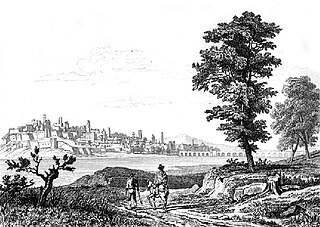
The Battle of the Gebora took place during the Peninsular War between Spanish and French armies on 19 February 1811, northwest of Badajoz, Spain. An outnumbered French force routed and nearly destroyed the Spanish Army of Extremadura.

In the Battle of Mansilla or Battle of Mansilla de las Mulas on 30 December 1808 an Imperial French corps led by Nicolas Soult caught up with a Spanish corps commanded by Pedro Caro, 3rd Marquis of la Romana. Soult's cavalry under Jean Baptiste Marie Franceschi-Delonne overran la Romana's rear guard led by General Martinengo. Mansilla de las Mulas is a town located 17 kilometres (11 mi) southeast of León, Spain. The combat occurred during the Peninsular War, part of the Napoleonic Wars.

The invasion of Portugal saw an Imperial French corps under Jean-Andoche Junot and Spanish military troops invade the Kingdom of Portugal, which was headed by its Prince Regent João of Bragança. The military operation resulted in the occupation of Portugal. The French and Spanish presence was challenged by the Portuguese people and by the United Kingdom in 1808. The invasion marked the start of the Peninsular War, part of the Napoleonic Wars.
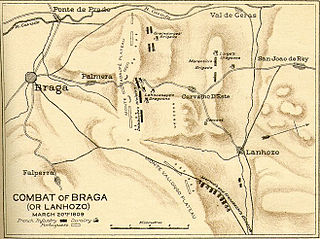
The Battle of Braga or Battle of Póvoa de Lanhoso or Battle of Carvalho d'Este saw an Imperial French corps led by Marshal Nicolas Soult attack a Portuguese army commanded by Baron Eben. When Soult's professional soldiers attacked, the Portuguese at first fought back but soon ran away. The French slaughtered large numbers of their opponents, who were mostly badly disciplined and poorly armed militia. The action was part of the second invasion of Portugal, during the Peninsular War.

The Battle of Alcántara saw an Imperial French division led by Marshal Claude Perrin Victor attack a Portuguese detachment under Colonel William Mayne. After a three hours skirmish, the French stormed across the Alcántara Bridge and forced the Portuguese to retreat. The clash happened during the Peninsular War, part of the Napoleonic Wars. Alcántara, Spain is situated on the Tagus river near the Portuguese border, 285 kilometres (177 mi) west-southwest of Madrid.

The Battle of Arzobispo on 8 August 1809 saw two Imperial French corps commanded by Marshal Jean-de-Dieu Soult launch an assault crossing of the Tagus River against a Spanish force under José María de la Cueva, 14th Duke of Alburquerque. Alburquerque's troops rapidly retreated after suffering disproportionate losses, including 30 artillery pieces. El Puente del Arzobispo is located 36 kilometres (22 mi) southwest of Talavera de la Reina, Spain. The action occurred during the Peninsular War, part of a larger conflict known as the Napoleonic Wars.
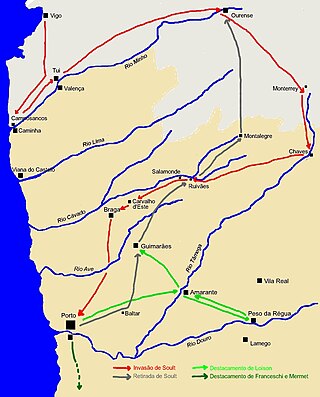
The Second French invasion of Portugal, a campaign of the Peninsular War, commenced on 3 February 1809 with French Marshal Soult's II Corps heading down from La Coruña, in the north of Spain to occupy the capital of Portugal, Lisbon.

The Battle of Monterrey was fought during the Peninsular War outside Monterrey, Orense, in Spain. Resulting in a French victory, it took place in the early stages of Marshal Soult's Second French invasion of Portugal.
